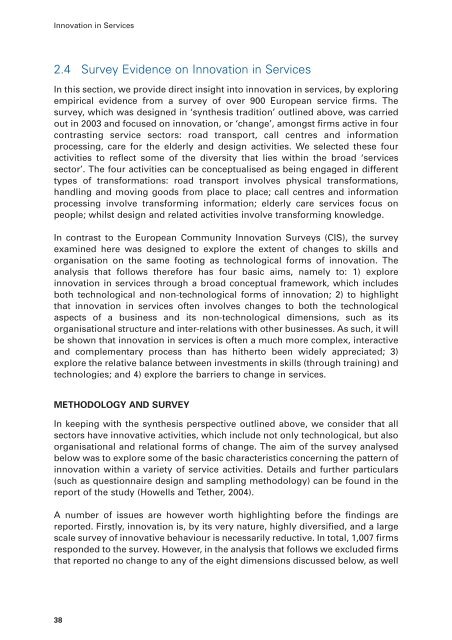Innovation in Services - Department for Business, Innovation and Skills
Innovation in Services - Department for Business, Innovation and Skills
Innovation in Services - Department for Business, Innovation and Skills
Create successful ePaper yourself
Turn your PDF publications into a flip-book with our unique Google optimized e-Paper software.
<strong>Innovation</strong> <strong>in</strong> <strong>Services</strong><br />
2.4 Survey Evidence on <strong>Innovation</strong> <strong>in</strong> <strong>Services</strong><br />
In this section, we provide direct <strong>in</strong>sight <strong>in</strong>to <strong>in</strong>novation <strong>in</strong> services, by explor<strong>in</strong>g<br />
empirical evidence from a survey of over 900 European service firms. The<br />
survey, which was designed <strong>in</strong> ‘synthesis tradition’ outl<strong>in</strong>ed above, was carried<br />
out <strong>in</strong> 2003 <strong>and</strong> focused on <strong>in</strong>novation, or ‘change’, amongst firms active <strong>in</strong> four<br />
contrast<strong>in</strong>g service sectors: road transport, call centres <strong>and</strong> <strong>in</strong><strong>for</strong>mation<br />
process<strong>in</strong>g, care <strong>for</strong> the elderly <strong>and</strong> design activities. We selected these four<br />
activities to reflect some of the diversity that lies with<strong>in</strong> the broad ‘services<br />
sector’. The four activities can be conceptualised as be<strong>in</strong>g engaged <strong>in</strong> different<br />
types of trans<strong>for</strong>mations: road transport <strong>in</strong>volves physical trans<strong>for</strong>mations,<br />
h<strong>and</strong>l<strong>in</strong>g <strong>and</strong> mov<strong>in</strong>g goods from place to place; call centres <strong>and</strong> <strong>in</strong><strong>for</strong>mation<br />
process<strong>in</strong>g <strong>in</strong>volve trans<strong>for</strong>m<strong>in</strong>g <strong>in</strong><strong>for</strong>mation; elderly care services focus on<br />
people; whilst design <strong>and</strong> related activities <strong>in</strong>volve trans<strong>for</strong>m<strong>in</strong>g knowledge.<br />
In contrast to the European Community <strong>Innovation</strong> Surveys (CIS), the survey<br />
exam<strong>in</strong>ed here was designed to explore the extent of changes to skills <strong>and</strong><br />
organisation on the same foot<strong>in</strong>g as technological <strong>for</strong>ms of <strong>in</strong>novation. The<br />
analysis that follows there<strong>for</strong>e has four basic aims, namely to: 1) explore<br />
<strong>in</strong>novation <strong>in</strong> services through a broad conceptual framework, which <strong>in</strong>cludes<br />
both technological <strong>and</strong> non-technological <strong>for</strong>ms of <strong>in</strong>novation; 2) to highlight<br />
that <strong>in</strong>novation <strong>in</strong> services often <strong>in</strong>volves changes to both the technological<br />
aspects of a bus<strong>in</strong>ess <strong>and</strong> its non-technological dimensions, such as its<br />
organisational structure <strong>and</strong> <strong>in</strong>ter-relations with other bus<strong>in</strong>esses. As such, it will<br />
be shown that <strong>in</strong>novation <strong>in</strong> services is often a much more complex, <strong>in</strong>teractive<br />
<strong>and</strong> complementary process than has hitherto been widely appreciated; 3)<br />
explore the relative balance between <strong>in</strong>vestments <strong>in</strong> skills (through tra<strong>in</strong><strong>in</strong>g) <strong>and</strong><br />
technologies; <strong>and</strong> 4) explore the barriers to change <strong>in</strong> services.<br />
METHODOLOGY AND SURVEY<br />
In keep<strong>in</strong>g with the synthesis perspective outl<strong>in</strong>ed above, we consider that all<br />
sectors have <strong>in</strong>novative activities, which <strong>in</strong>clude not only technological, but also<br />
organisational <strong>and</strong> relational <strong>for</strong>ms of change. The aim of the survey analysed<br />
below was to explore some of the basic characteristics concern<strong>in</strong>g the pattern of<br />
<strong>in</strong>novation with<strong>in</strong> a variety of service activities. Details <strong>and</strong> further particulars<br />
(such as questionnaire design <strong>and</strong> sampl<strong>in</strong>g methodology) can be found <strong>in</strong> the<br />
report of the study (Howells <strong>and</strong> Tether, 2004).<br />
A number of issues are however worth highlight<strong>in</strong>g be<strong>for</strong>e the f<strong>in</strong>d<strong>in</strong>gs are<br />
reported. Firstly, <strong>in</strong>novation is, by its very nature, highly diversified, <strong>and</strong> a large<br />
scale survey of <strong>in</strong>novative behaviour is necessarily reductive. In total, 1,007 firms<br />
responded to the survey. However, <strong>in</strong> the analysis that follows we excluded firms<br />
that reported no change to any of the eight dimensions discussed below, as well<br />
38
















